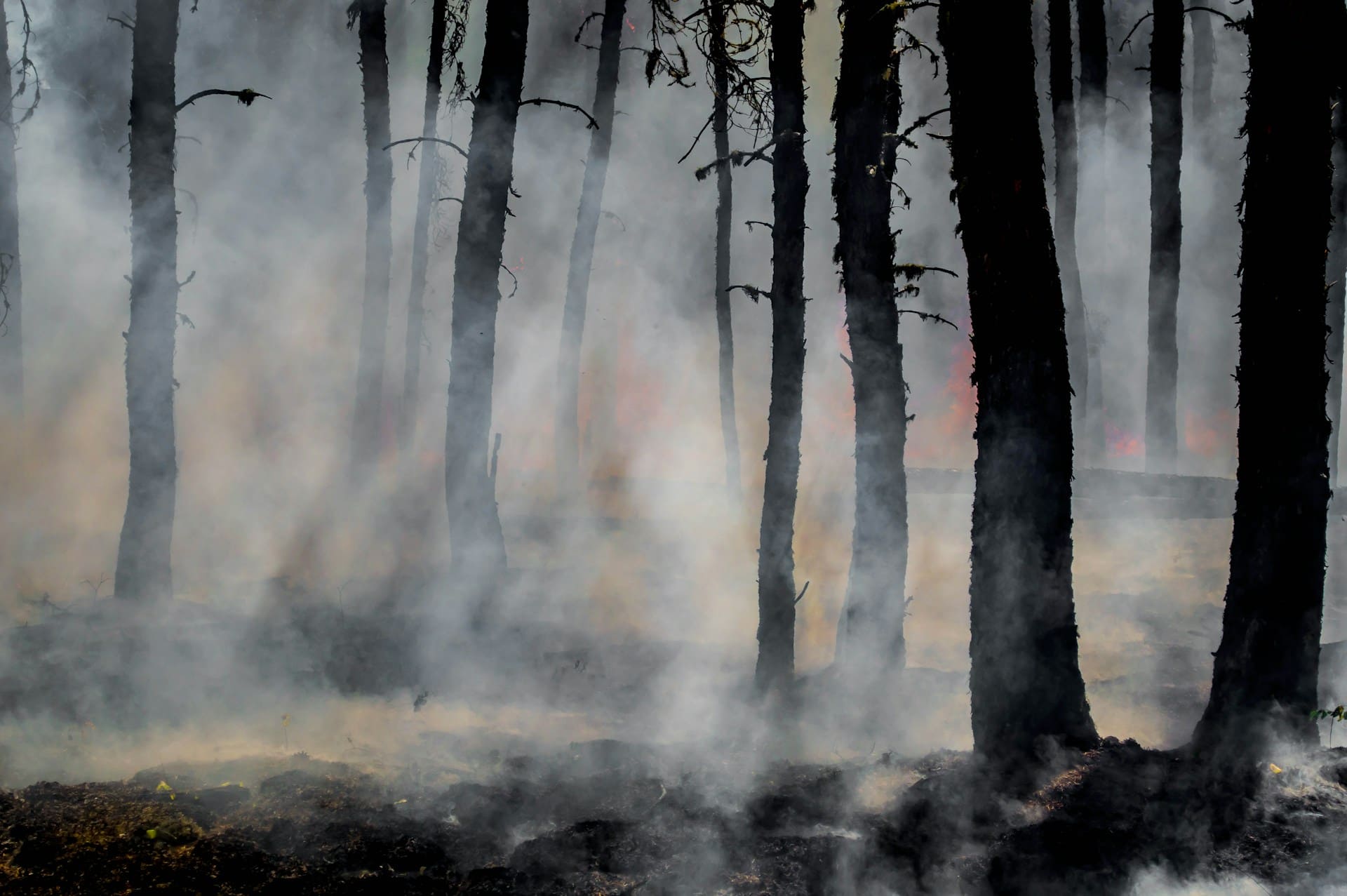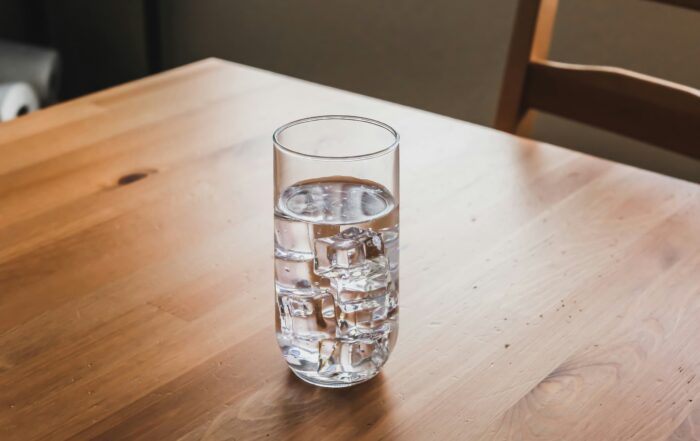Can wildfire smoke damage the watershed?

Wildfire smoke is becoming a more common occurrence in Canadian forests (Joanne Francis, Unsplash)
The North American wildfire season has begun with another broken record. At the end of February, Texas suffered its worst wildfire in state history, the blaze covering 4,400 square kilometres. Plumes of smoke billowed over southeastern Manitoba and northwestern Ontario, a haze settling over the land.
Wildfire smoke contains particulate matter, a collection of particles that are suspended in the air and primarily formed from chemical reactions in the atmosphere and through fuel combustion. Fine particulate matter, or PM 2.5, are particles 2.5 microns in diameter or less — and are extremely dangerous to human health. The particles are small enough to penetrate the respiratory system and exposure is associated with serious health effects, according to Air Quality Ontario.
“When air pollutants are emitted, they’re typically either in a gas phase or they’re in a small particle, a small aerosol particle. And that may be solid or liquid, or solid-liquid mixture. And the two types of the two forms of the pollutant, they behave differently,” says Michael D. Moran, a research scientist in the air quality branch of Environment and Climate Change Canada.
While the PM 2.5 concentration emitted from the Texas wildfire was low and posed no threat to Ontario air quality, it could still indirectly impact local waterways, including the watershed and the Great Lakes. Airborne particles, even in small concentrations, can settle on surfaces and affect water quality when they encounter precipitation.
“[The particles] settle very slowly, but the gravity pulls them down to the ground,” says Moran. “It’s much more likely that they will reach the water body if it’s in the particle phase.”
Fine particles gather on the surface of lakes and creeks, clouding the water and reducing its clarity. This reduced visibility can hinder the penetration of sunlight into the water,affecting the growth of aquatic plants and the overall health of ecosystems.
Particulate matter also poses a threat to native fish and small aquatic species. According to a 2023 study in Comparative Biochemistry and Physiology, when fish consume particles that settle in the water, hazardous contaminants can accumulate in fish tissue, posing health risks to both the fish and the creatures who eat them.
The Great Lakes is in a compromising location for wildfire smoke and particle pollution. Wildfire smoke can travel great distances across the country from the northwest to the southeast, and significant amounts of PM 2.5 are carried into Ontario from the U.S.
As of yet, there is no evidence to suggest the particulate matter from the Texas wildfire has had any harmful effects on the Great Lakes.
The Unbalanced Paddleboarder

Canadian Canoe Museum (https://canoemuseum.ca/)
Adventurer and author, Mike Shoreman, also known as The Unbalanced Paddleboarder, paddled across all five of the Great Lakes in 2022. Now, his board and gear from his extraordinary voyage will be exhibited in the new Canadian Canoe Museum in Peterborough, Ont.
In 2018, Shoreman, who was 38 at the time, was diagnosed with Ramsay Hunt syndrome (RHS), a chronic neurological condition caused by the reaction of the varicella zoster virus. He suffered severe symptoms including excruciating pain, dizziness, vertigo, hearing loss and speech, vision and mobility problems. He was told he would never paddleboard again, causing him to have a crisis of mental health.
But Shoreman had long been a professional paddler and avid athlete — and underwent intense physiotherapy to try to recover his balance and mobility, as well as support for his mental health. Four years later Shoreman completed the crossings in a single summer in 2022, becoming the first disabled person to cross all five lakes on a paddleboard. He has since become a well known speaker, and has written a book about his experience with RHS. He also made the award-winning film When Hope Breaks Through.
“The different recognition that has come since the crossings, that has kept on going and building, has come to the point where it can be used as an education piece,” Shoreman told Whitby This Week.
The exhibit in the Canoe Museum will be the first to “have a mental health education or disability component about it,” he says. “It’s a huge honour for me.”
The exhibit starts on May 11, 2024.
Early warming of lakes leads to worse-off walleye

Walleye are a common sport fish (Zab Consulting, Unsplash)
Climate change is causing lakes in the U.S. Midwest to thaw about three times faster than walleye, a freshwater fish, can adapt, according to a recent study in Limnology and Oceanography Letters.
Phytoplankton typically bloom when the ice melts in the spring, feeding zooplankton which are in turn gobbled up by juvenile walleye. But “in a year where we have a really warm spring and the ice melts really early, we can see that there’s these blooms of phytoplankton and then zooplankton that occur actually before walleye hatch,” says study lead author Martha Barta, a research technician at the University of Wisconsin-Madison. “Then by the time that the walleye babies hatch, there’s not really a lot of food resources around for them and survival can be really low.”
The researchers worry that walleye spawning is so tightly entwined with ice thaw that changes to the latter will have huge consequences for the fish’s reproductive success. As predator fish native to the Great Lakes, they have often been used in conservation to control other fish populations. Less walleye in the basins could throw other populations out of balance, while impacting communities like the Wisconsin Ojibwe tribes who rely on them as a food source.
Walleye — ogaa in Anishinaabemowin — are also of ceremonial importance to Nations and tribal members in the US. Any environmental changes that threaten walleye populations are of high concern to Wisconsin Tribes, says climate change coordinator Rob Croll of the Great Lakes Indian Fish and Wildlife Commission’s. The walleye harvest is so important that the right to spearfish is enshrined in the Treaties of 1837 and 1842. Prior to federal policies and treaties that confined tribes to reservations, Croll says tribal members would simply move when a food source disappeared.
“If there weren’t any walleye in this particular lake, you went to another one. Now, if climate change means that walleye is only found outside of the ceded territories, or in Canada, the tribes just can’t pick up and move and practice their rights somewhere else,” Croll says. “Those rights are legally fixed in place.” Wisconsin tribes harvest around 30,000 walleye each year in ceded territory while state anglers harvest almost eight times as many fish in the same region.



